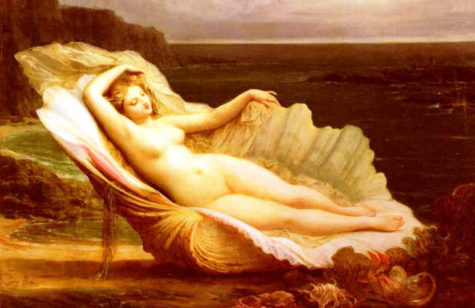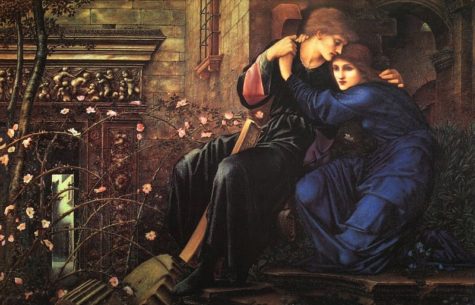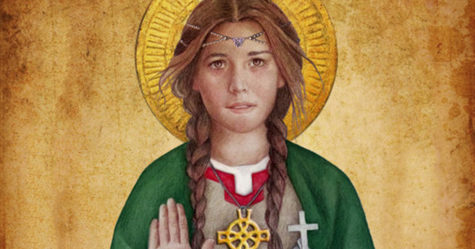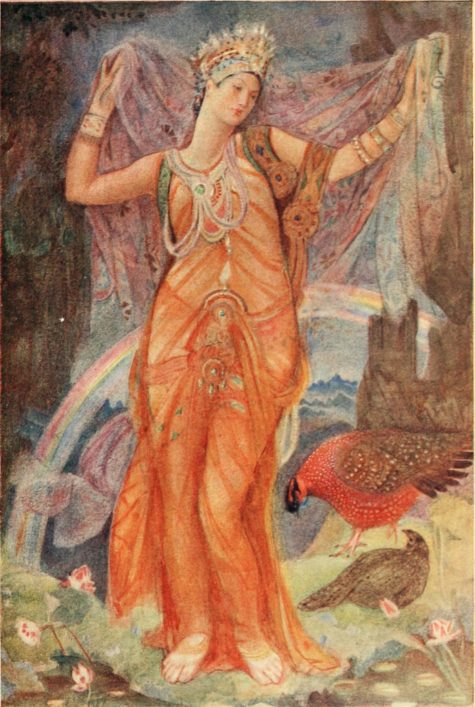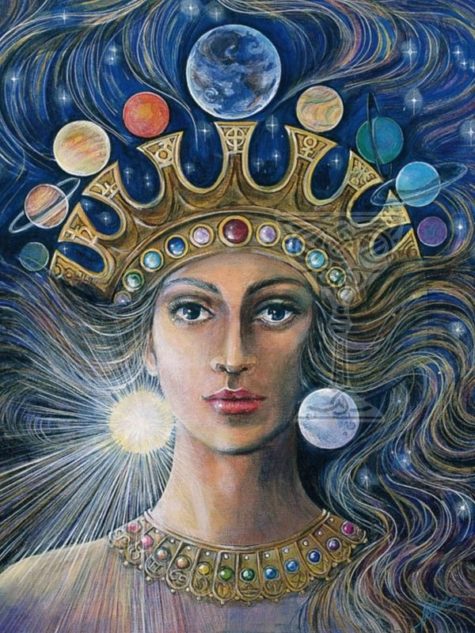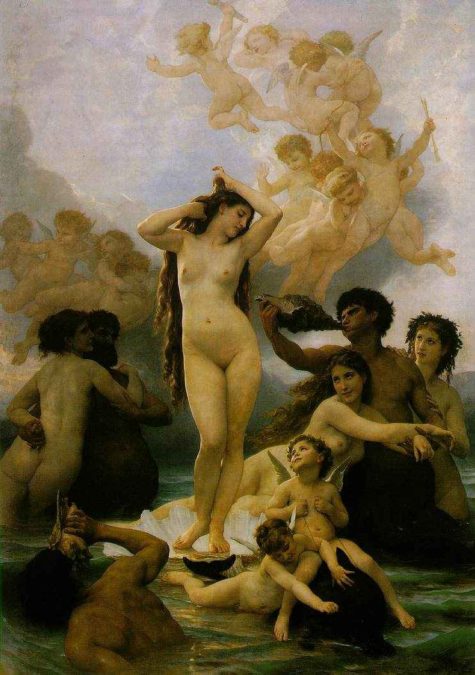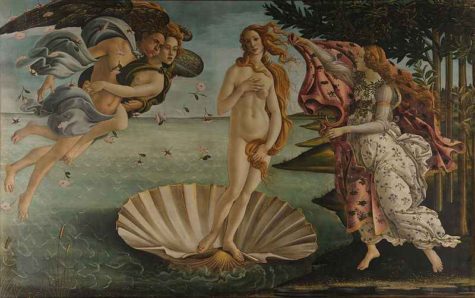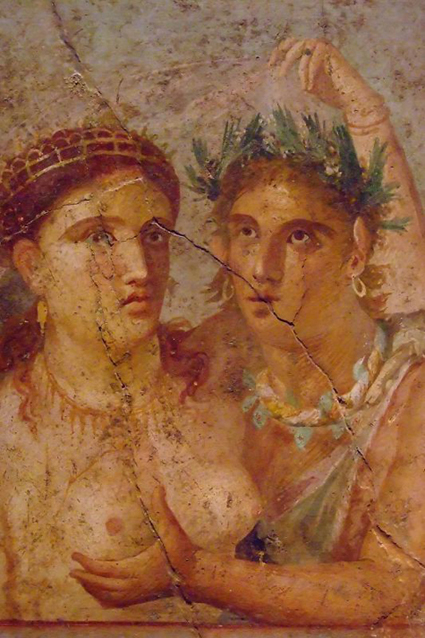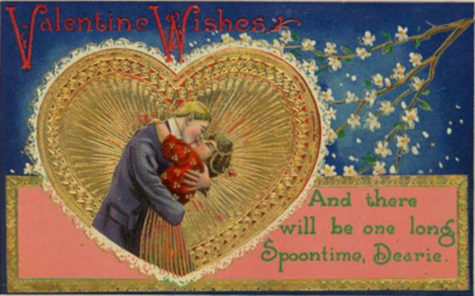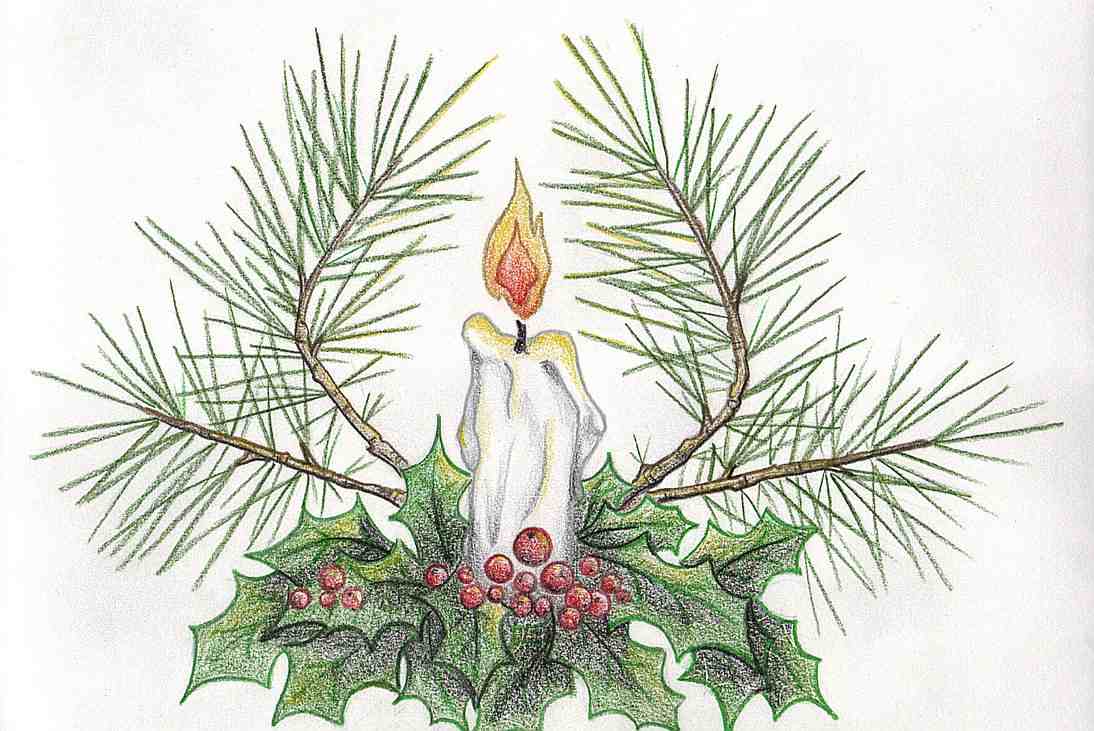Love
Aphrodisia, festival of Aphrodite, ancient Greece was, according to Wilson’s Almanac celebrated on or around February 6th. If you’d like to invoke the Goddess of love, sex, and beauty, you can prepare for a feast honoring Aphrodite’s loving sensuality and warmth.
- Decorate with pink carnations; they are the flowers of friendship.
- Burn warm yellow sandalwood scented candles – sandalwood loosens inhibitions.
- Put symbols of love including pomegranates, apples, and seashells out in blue ceramic or crystal bowls.
- Invite friends to bring an aphrodisiac food for sharing (cherries, oysters, papaya, chocolate, truffles, red wine, etc).
- Open a window or door slightly.
- Join hands around the dinner table.
Recite this invocation:
Aphrodite, Greek goddess of friendship, love, and life
Come join us, bring peace and eliminate all strife
We welcome you with fruit, flowers, fire, and fresh air
Release us from anxiety, stress, or despair
Come down; be with us
Grace us this special day
We call you with love
We hope you will stay.
Repeat three times with sincerity.
Who is Aphrodite?
Aphrodite is the Olympian goddess of love, beauty, sexual pleasure, and fertility. She is regularly attended by few of her children, the Erotes, who are capable of stirring up passion in both mortals and gods at the goddess’ will.
Portrayed as both insatiable and unattainable, Aphrodite was born near the coast of Cythera out of the foam (aphros) Uranus’ castrated genitals created when they fell into the sea. Even though married to Hephaestus, she had affairs with all Olympians except Zeus and Hades, most famously with Ares, the god of war. She also had famous romances with two mortals, Anchises and Adonis.
A Ritual for The Aphrodesia
- Colors: Sea green and white
- Element: Water
- Offerings: Shells. Fishes. Promises to aid expectant parents.
- Daily Meal: Ocean fish. Shellfish. Sweet things, especially desserts. Whipped cream.
Altar:
Lay with a cloth of sea green, strings of pearls, white lace, many scallop shells, colored glass sea floats, abalone, small shells with hearts and fishes painted on them, and a large chalice of Greek wine with frothy sugared egg whites floating in it.
Invocation to Aphrodite Genetrix
Lady of Sea-Foam,
Green as the ocean from which
You sprang, with pearls
Of whitest foam,
Aphrodite Genetrix
Love that creates all Life,
We thank you for the Love
That sparked our existence.
We remember that we were all born of love
Whether it was brief and poignant
As a firefly’s courtship
Or solid and lasting
For half a century,
Whether it sprang from the body
Or the heart, or the soul.
You who bind the proton to the electron
And so bind the world together,
May we never forget your gift of attraction
That makes us all human
Even as you are divine.
Chant:
Amor Invictus
Amor Invictus
The ritual for this day is the Great Rite, performed by one man and one woman, as Aphrodite Genetrix is the matron of procreative sexuality. If done symbolically, the man plunges a blade into the chalice held by the woman, and then it is poured as a libation.
Ideally, it should be done literally, either by members of the house or by two who have come in for this purpose. If outsiders, it would be an auspicious time to conceive a child. All sit facing outwards in a circle and chant as the couple are wrapped in a red cloth and lay together in the center, and when it is done all repair to their rooms and either contemplate love or have ritual sex, alone or together.
Sources:
January 21 is the Eve of St Agnes. There are many traditions associated with both this night and tomorrow night, all intended to bring dreams of the future husband. Here are some of them.
- Walking thrice backwards around a churchyard in silence at midnight, scattering hemp seed over the left shoulder.
- Boiling an egg, removing the yolk and filling the center with salt and then eating the whole, shell included!
- Sticking 9 pins into a red onion, taking it backwards to the bedroom and sleeping with it under the pillow.
But the most often repeated one is that of making a Dumb Cake. Here are the instructions:
Three, five or seven maidens should gather together on St Agnes Eve and make a cake from flour, salt, eggs and water. While they are mixing and baking the cake all the girls should stand on something different and which they have never stood on before. Each girl should take a hand in adding each of the ingredients and each girl should turn the cake once. When the cake is baked they should eat it all between them. Then, walking backwards, they should all retire to bed where they will dream of their future husbands. The whole process from start to finish should take place in complete silence and should be completed just before midnight.
It is interesting that all these methods include the elements of silence, walking backward, and retiring to bed at midnight.
Here are some more old old spells for St Agnes night:
On Saint Agnes’ night, take a row of pins and pull out every one, one after another, saying a Pater Noster, sticking a pin in your sleeve, and you will dream of him or her you will marry. “Knit tne left garter about the right-legg’d stocking” (let the other garter and stocking alone), and as you rehearse these following verses, at every comma knit a knot:
“This knot I knit,
To know the thing I know not yet,
That I may see
The man that shall my husband be,
How he goes and what he wears.
And what he does all the days.”
Accordingly in your dream you will see him, if a musician, with a lute or other instrument; if a scholar, with a book,” and so on.
Another dream-charm for St . Agnes’ Eve was to take a sprig of rosemary and another of thyme and sprinkle them thrice with water, then place one in each shoe, and stand shoe and sprig on either side of the bed, repeating:
“St Agnes, that’s to lovers kind.
Come ease the trouble of my mind.”
In many places the notion prevailed that to insure the perfection of these charms the day must be spent in fasting. It was called “St . Agnes’ fast.”
Keat’s beautiful lines commemorative of the day seem doubly exquisite when read after conning the clumsy folk-rhymes:
They told me how upon St. Agnes’ Eve
Young virgins might have visions of delight,
And soft adorings from their loves receive
Upon the hony’d middle of the night.
IF ceremonies due they did aright;
As supperless to bed they must retire
And couch supine their beauties lily white;
Nor look behind, nor sideways, but require
Of heaven with upward eyes for all that they desire.
In Scotland the lasses sow grain at midnight on St . Agnes Eve, singing,—
“Agnes sweet and Agnes fair
Hither, hither now repair.
Bonny Agnes, let me see
The lad who is to marry me.”
And the figure of the future sweetheart appears as if reaping the grain.
Here is yet another one:
A key is placed in the Bible at the second chapter of Solomon’s Song, verses 1, 5 and 17, and the book tied firmly together, with the handle of the key left beyond the edges of the leaves. The tips of the little finger of the charm-tester and of a friend are placed under the side of the key, and then they “tried the alphabet” with the verses above named; that is, they began thus:
“A. My beloved is mine, and I am his. He feedeth among the lilies. Until the day break and the shadows fall away, turn, my beloved,” etc.
At the word “turn” the Bible was supposed to turn around if A were the first letter of the lover’s name. Thus could the entire name be spellled out.
Found in
Dwynwen was Wales’ patron saint of lovers, and January 25th is the Welsh equivalent to St Valentine’s Day. However, it is a romantic country, and they also celebrate St Valentine’s day on 14 February!
She is also known as:
- Dwyn
- Donwen
- Donwenna
- Dunwen
Her most well known saying is “Nothing wins hearts like cheerfulness”
The story of Dwynwen dates back to the 5th century. She was a beautiful Celtic princess, the prettiest of all the King of Wales’s 24 daughters (Brychan Brycheiniog of Brechon also had 11 sons!).
Dwynwen was in deeply in love with the handsome Maelon Dafodrill, but her father had already betrothed her to another, so he refused to give them his consent. On finding out, Maelon cruelly forced himself upon her and fled. With a broken heart, and grieved to have upset her father, Dwynwen ran to the woods and begged God to make her forget her love for Maelon.
Exhausted and aungished, Dwynwen eventually fell asleep. Whilst dreaming, an angel visited her and left a sweet smelling potion. This would erase all memories of Maelon, and his callous heart would also be cooled, but so much so that he turned to ice. Dwynwen was horrified to find her love frozen solid. She prayed again to God, who answered her prayers by granting her three wishes.
Her first wish was to have Maelon thawed and for him to forget her; her second, to have God look kindly on the hopes and dreams of true lovers whilst mending the broken hearts of the spurned; and her third was for her to never marry, but to devote the remainder of her life to God, as thanks for saving Maelon.
Dwynwen devoted the rest of life to God’s service. She became a nun and lived on Llanddwyn Island on the western coast of Ynys Mon (Anglesey), an area accessible only at low tide. She founded a church there, remains of which can still be seen today. After her death she was declared the Welsh Patron Saint of Lovers and ever since, Welsh lovers have looked to St Dwynwen for her help in courting their true love, or for forgetting a false one.
On the island there is a well where, according to legend, a sacred fish (an eel) swims. It is said that the eel can predict the happiness of relationships.
Her well, a fresh-water spring called Ffynnon Dwynwen, became a wishing well and place of pilgrimage, particularly for lovers because of the story above. The tradition grew that the eel in the well could foretell the future for lovers – ask questions and watch which way they turn. Women would scatter breadcrumbs on the surface, then lay her handkerchief on water’s surface; if the eel disturbed it, her lover would be faithful.
Visitors still go to the well today, hoping that the water will boil, meaning that love and good luck will follow them. Her well continues to be a place of pilgrimage; there’s a tradition that if the fish in the well are active when a couple visits, it’s the sign of a faithful husband.
Visitors would leave offerings at her shrine, and so popular was this place of pilgrimage that it became the richest in the area during Tudor times. This funded a substantial chapel that was built in the 16th century on the site of Dwynwen’s original chapel.
Prayer To St Dwynwen
Oh Blessed St. Dwynwen, you who knew pain and peace, division and reconciliation. You have promised to aid lovers and you watch over those whose hearts have been broken. As you received three boons from an Angel, intercede for me to receive 3 blessings to obtain my heart’s desire (state request) and if that is not God’s will, a speedy healing from my pain; your guidance and assistance that I may find love with the right person, at the right time, and in a right way; and an unshakeable faith in the boundless kindness and wisdom of God and this I ask in the name of Jesus Christ our Lord. Amen.
St. Dwynwen, we beseech thee, comfort lovers whose vision is unclear. Send mending to those with love lost. Protect companions. In your name we seek to do the same. In your name we choose love first. With the love of you, Mary and of Jesus Christ. Amen.
Sources:
- Themes: Love; Fertility; Passion; Sexuality; Moon
- Symbols: Star; Moon; Lion; Dove
- Color: Gold
- Incense: Eucalyptus
Sometimes known as the sacred prostitute of Babylon, is the Babylonian goddess of fertility, sexual love, and war, Ishtar encompasses the fullness of womanhood, including being a maternal nurturer, an independent companion, an inspired bed partner, and an insightful adviser in matters of the heart.
Having descended from Venus (the planet that governs romance), she is the moon, the morning star, and the evening star, which inspire lovers everywhere to stop for a moment, look up, and dare to dream. Saturday is Ishtar’s traditional temple day, and her sacred animals include a lion and a dove.
Babylonians gave Ishtar offerings of food and drink on this day. They then joined in ritual acts of lovemaking, which in turn invoked Ishtar’s favor on the region and its people to promote continued health and fruitfulness.
That being said, allow yourself today to reflect on embracing your own sexual being. On a piece of paper, list things about your body and your sexuality that make you uncomfortable. Then, light a pink candle and send pink, healing light to any parts of yourself with which you have emotional discomfort. Embrace your sexual self for who you are and find peace within. After spending time for yourself, consider your own sexual relationships. Focus energy on things within them that are not right and comfortable for you. Send healing to those areas as well. Your sexual relationships should bring joy and pleasure into your life. Remember to be safe in them as well. Thank Ishtar for her presence in your life. Finish your meditations and enjoy the vibrancy of the day.
A magickal alternative, if you have no bed partner, is to use symbolism. Place a knife (or athame, a ritual dagger often representing the masculine divine or the two-edged sword of magick) in a cup filled with water. This represents the union of yin and yang. Leave this in a spot where it will remain undisturbed all day to draw Ishtar’s loving warmth to your home and heart.
If you have any clothes, jewelry, or towels that have a star or moon on them, take them out and use them today. Ishtar abides in that symbolism. As you don the item, likewise accept Ishtar’s mantle of passion for whatever tasks you have to undertake all day.
A Ritual For Ishtar’s Day
- Color: Pottery red, terra cotta
- Element: Earth
- Offerings: Grains. Stars. Give food to those who need it.
- Daily Meal: Wholegrain bread. Cooked grains. Milk and dairy products.
Altar: Set with a cloth of earthy red, and on it place a pitcher of milk and another of wine, bowls of wood and clay filled with grains, olives, figs, and dates, a star, and the figure of a lioness.
Ishtar Invocation
I beseech thee, Lady of Ladies,
Goddess of Goddesses,
Ishtar, queen of all cities,
Leader of all men.
Thou art the light of the world,
Thou art the light of heaven.
At thy name the earth and the heavens shake,
And the gods they tremble;
The spirits of heaven tremble at thy name
And the men hold it in awe.
Where thou glancest the dead come to life,
And the sick rise and walk;
And the mind that is distressed is healed
When it looks upon thy face.
Call and response:
For lo, I am the Keeper of the Storehouse
And I am generous to all men!
From my breasts nourishment spills
From my hands nourishment flows
From my heart nourishment streams
I am the Morning Star
I am the Evening Star
I am the Star of Heaven
And I give unto all humanity.
(After this, all should being the work of inventorying all the resources of the house, in Ishtar’s name, so that they may be used more efficiently and that it can be known what can be given to others out of generosity.)
Sources:
The Veneralia (April 1) was the Ancient Roman festival of Venus Verticordia (“Changer of hearts”), the goddess of love and beauty. The worship of the goddess Fortuna Virilis (“Bold fortune”) was also part of this festival.
In Rome, jewelry was ritually removed from the statue of the goddess, her image was then taken from her temple to the men’s baths, where it was undressed and washed in warm water by her female attendants, then garlanded with myrtle.
Similarly, women bathed themselves in the public baths wearing wreaths of flowers and myrtle on their heads. It was generally a day for women to seek divine help in their relations with men. Men also asked Venus Verticordia for her help in affairs of the heart, sex, betrothal and marriage.
Here’s a nice ritual for the Day of Venus:
- Color: Sea green, golden, and pink
- Element: Water
- Altar: Upon cloth of sea green, golden and pink, set many shells, flowers, beautiful ornaments, pink candles, hearts, doves, incense of rose and violets, and a great chalice of white wine.
- Offerings: Hearts and flowers. Giving a gift of love to someone.
- Daily Meal: Seafood. Angel hair pasta. Sweet breads, cakes, and desserts.
Invocation to Venus
Hail, Lady of the Morning Star!
You who rose form the sea foam,
Born of the impersonal severed phallus of the sky
Immersed in the impersonal womb of the sea,
You who rode to shore on a shell of pearl
And whose powers no one can resist
Save the virgin goddesses,
You who bring the glow of gold
Into the lives of all whom you touch,
Lady, we revere you as the avatar
Of the love between equals
Who look each other in the eye,
The attraction and pursuit
Between every particle in the universe.
Hail, Lady of the Evening Star!
You who rule the night
With its darker passions,
You who tempt the wistful heart,
You whose hands reach out
To all the world and more,
Lady, we revere you as a force of nature
Far greater than merely the human heart,
For you are the force that binds together
All that dances with another of its kind
In the endless dance of creation.
(The wine is passed around, and poured as a libation to Venus. Each takes a flower and wears it in honor of Venus.)
Chant:
Venus Veritas
Amor Amor
Source: Wikipedia and Pagan Book of Hours
- Ruler: Freya, Venus
- Colors: Emerald green or pink
- Power Hours: Sunrise and the 8th, 16th, and 24th hours following.
- Key Words: Love, money, health
 It is easy to spot the ruler of this day by its name. In the word Friday, we see the roots of the name of the Norse goddess Freya, a goddess of love and fertility, and the most beautiful and propitious of the goddesses thus the verse “Friday’s child is loving and giving.”
It is easy to spot the ruler of this day by its name. In the word Friday, we see the roots of the name of the Norse goddess Freya, a goddess of love and fertility, and the most beautiful and propitious of the goddesses thus the verse “Friday’s child is loving and giving.”
In Spanish this day of the week is called Viernes and is derived from the goddess Venus. Matters of love, human interaction, the fluidity of communication, sewing and the creation of artistic garments, household improement, shopping, and party planning all fall under the aspects of Friday and its ruling planet, Venus.
Friday’s angels are Ariel/Uriel, Rachiel, and Sachiel. Rachiel also concerns himself with human sexuality and is a presiding spirit of the planet Venus.
On Fridays, the hour of sunrise and every eight hours after that are also ruled by Venus, and that makes these times of the day doubly blessed. These four hours are the strongest four hours for conducting ritual. Check the local newspaper, astrological calendar, or almanac to determine your local sunrise.
From:
Valentine’s Day has its roots in ancient orgiastic festivals. On February 14, The Romans celebrated Febris (meaning fever), a sacred sexual frenzy in honor of Juno Februa, an aspect of the goddess of amorous love. This sex fest coincided with the time when the birds in Italy were thought to mate.
The ecstatic rites of the Goddess merged over time with those of Lupercalia, the bawdy festivities in honor of the pagan god of sex, drugs and rock-n-roll, Pan, which were observed on the following day, February 15.
On Lupercalia, (named, incidentally, in honor of the she-wolf who suckled Romulus and Remus), men and women inscribed their names on love notes or billets and then drew lots to determine who their sex partner would be during this anything goes festival of erotic games.
Sulpicia, a first century BC Roman poet, describes her participation in the events with hearty candor:
“At last love has come. I would be more ashamed
to hide it in cloth than leave it naked.
I prayed to the Muse and won. Venus dropped him
in my arms, doing for me what she
had promised. Let my joy be told, let those
who have none tell it in a story.
Personally, I would never send off words
in sealed tablets for none to read.
I delight in sinning and hate to compose a mask
for gossip. We met. We are both worthy.”
Roman armies took their Lupercalia customs with them as they invaded France and Britain. One of these was the above mentioned lottery where the names of available maidens were placed in a box and drawn out by the young men. Each man accepted the girl whose name he drew as his love – for the duration of the festival, or sometimes longer.
Lupercalia, with its lover lottery, had no place in the new Christian order. In the year 496 AD, Pope Gelasius did away with the festival of Lupercalia, citing that it was pagan and immoral. He chose Valentine as the patron saint of lovers, who would be honored at the new festival on the fourteenth of every February. The church decided to come up with its own lottery and so the feast of St. Valentine featured a lottery of Saints. One would pull the name of a saint out of a box, and for the following year, study and attempt to emulate that saint.
The Feast of St. Valentine and the saint lottery lasted for a couple hundred years, but the church just couldn’t rid the people’s memory of Lupercalia. In time, the church gave up on Valentine all together. The lottery finally returned to coupling eligible singles in the 15th century. The church attempted to revive the saint lottery once again in the 16th century, but it never caught on.
During the medieval days of chivalry, the single’s lottery was very popular. The names of English maidens and bachelors were put into a box and drawn out in pairs. The couple exchanged gifts and the girl became the man’s valentine for a year. He wore her name on his sleeve and it was his bounded duty to attend and protect her. The ancient custom of drawing names on the 14th of February was considered a good omen for love.
By the early 1600s, handmade valentines were customarily sent from admirers to sweethearts. About 1800 the first commercial cards appeared. Cards were usually sent anonymously. As early as 1822, an English official reported having to hire extra postal workers on this day. In 1849, Esther Howland of Worcester, Massachusetts, started selling quality valentines so popular that she was called “Mother of the American Valentine.”
Sources:
 The Halcyon Days occur on or around Dec 14, and last for approximately 2 weeks. The legend of these “days” centers around Halcyone, the wife of King Ceyx of Thessaly. It happened that King Ceyx was obliged to take a distant journey, far away over the seas. One night during his absence a very heavy storm came up, and the winds blew a gale.
The Halcyon Days occur on or around Dec 14, and last for approximately 2 weeks. The legend of these “days” centers around Halcyone, the wife of King Ceyx of Thessaly. It happened that King Ceyx was obliged to take a distant journey, far away over the seas. One night during his absence a very heavy storm came up, and the winds blew a gale.
Halcyone, being the daughter of the wind-god, Aeolus, knew well what her brothers, the Winds, could do, and passed the night in great terror. The next day she walked back and forth all day on the shore, longing for tidings of her husband’s ship, yet fearing to know what might have happened. She was almost beside herself, and did not know what to do,.
The Gods took pity on her, and that night, Somnus, the god of sleep and dreams, sent a dream to Halcyone, – a dream of a wreck at a place some distance down the coast. Early the next morning, Halcyone ran to the place of which she had dreamed. She saw floating beams, and something bright among them – something which shone like the king’s crown.
Having a sudden longing to go to this spot, she started forward, and immediately felt herself raised on wings and carried out over the tossing waves, for the Gods had changed her into a bird. With a loud cry, Halcyone flew to her Ceyx. Just as she lit on the floating beams, the bright crown became a crest of feathers, and the dead king a living bird with plumage like Halcyone’s own.
So, after all, Ceyx and Halcyone were not separated. The air was as fresh and the sunshine as bright as ever. They could still be happy as kingfishers. After this, every year, the two birds built a nest which floated on the sea. During the fourteen days that Halcyone sat brooding, there was never a breath of wind stirring, but the sea was as smooth as glass, for aeolus watched over the waters. From that time, days of fine weather and calm seas, in midwinter, have been called “halcyon days.”
An alternative version of the story is that she knew her husband had drowned, and overcome by grief, Halcyone flung herself into the ocean and drowned along with him. At which point, the Gods took pity on the pair and transformed them into kingfishers, or halcyons, with the power to still the stormy seas for 14 days near the time of the winter solstice while they hatched their young.


